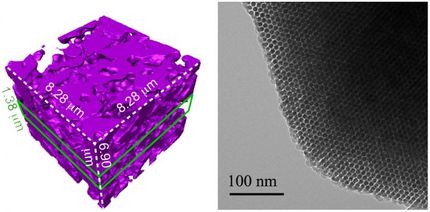Neural networking nanotubes
Bridging neurons and electronics with carbon nanotubes
New implantable biomedical devices that can act as artificial nerve cells, control severe pain, or allow otherwise paralyzed muscles to be moved might one day be possible thanks to developments in materials science. Nicholas Kotov of the University of Michigan, USA, and colleagues describe how they have used hollow, submicroscopic strands of carbon, carbon nanotubes, to connect an integrated circuit to nerve cells. The new technology offers the possibility of building an interface between biology and electronics.
Kotov and colleagues at Oklahoma State University and the University of Texas Medical Branch have explored the properties of single-walled nanotubes (SWNTs) with a view to developing these materials as biologically compatible components of medical devices, sensors, and prosthetics. SWNTs are formed from carbon atoms by various techniques including deposition and resemble a rolled up sheet of chicken wire, but on a tiny scale. They are usually just a few nanometers across and up to several micrometers in length.
The researchers built up layers of their SWNTs to produce a film that is electrically conducting even at a thickness of just a few nanometers. They next grew neuron precursor cells on this film. These precursor cells successfully differentiated into highly branched neurons. A voltage could then be applied, lateral to the SWNT film layer, and a so-called whole cell patch clamp used to measure any electrical effect on the nerve cells. When a lateral voltage is applied, a relatively large current is carried along the surface but only a very small current, in the region of billionths of an amp, is passed across the film to the nerve cells. The net effect is a kind of reverse amplification of the applied voltage that stimulates the nerve cells without damaging them.
Kotov and his colleagues report that such devices might find use in pain management, for instance, where nerve cells involved in the pain response might be controlled by reducing the activity of those cells. An analogous device might be used conversely to stimulate failed motor neurons, nerve cells that control muscle contraction. The researchers also suggest that stimulation could be applied to heart muscle cells to stimulate the heart. They caution that a great deal of work is yet to be carried out before such devices become available to the medical profession.
Original publication: Nicholas A. Kotov et al.; "Stimulation of Neural Cells by Lateral Currents in Conductive Layer-by-Layer Films of Single-Walled Carbon Nanotubes"; Advanced Materials 2006, 18, No. 22.
Most read news
Topics
Organizations
Other news from the department science
These products might interest you

Hose pressure transducer by HiTec Zang
Contactless pressure measurement for sterile applications
Easy-to-install tubing pressure sensors for diameters from 4.8-19.1 mm

FireSting-PRO by PyroScience
New fiber optic measuring device: Precise measurements even in the smallest volumes
Measure pH, oxygen and temperature even under sterile conditions

Get the life science industry in your inbox
By submitting this form you agree that LUMITOS AG will send you the newsletter(s) selected above by email. Your data will not be passed on to third parties. Your data will be stored and processed in accordance with our data protection regulations. LUMITOS may contact you by email for the purpose of advertising or market and opinion surveys. You can revoke your consent at any time without giving reasons to LUMITOS AG, Ernst-Augustin-Str. 2, 12489 Berlin, Germany or by e-mail at revoke@lumitos.com with effect for the future. In addition, each email contains a link to unsubscribe from the corresponding newsletter.
Most read news
More news from our other portals
Last viewed contents
Mendelian_inheritance

SARS-CoV-2: Cell phone and genome data allow targeted tracing of infection pathways - Scientists from the Jena start-up nanozoo GmbH and Jena University Hospital present analysis
Graphene shown to safely interact with neurons in the brain
Boots_Group

Efficiently smuggling drugs into cells - New method makes it easier than before to test new therapies

How fructose in the diet contributes to obesity - “Fructose itself is not harmful. It's a problem of overconsumption. Our bodies were not designed to eat as much of it as we do.”
Haplogroup_R_(Y-DNA)



















































